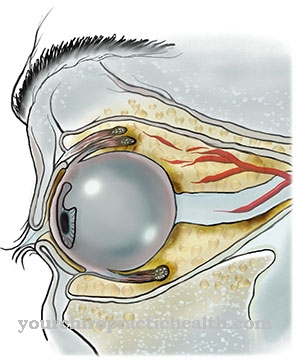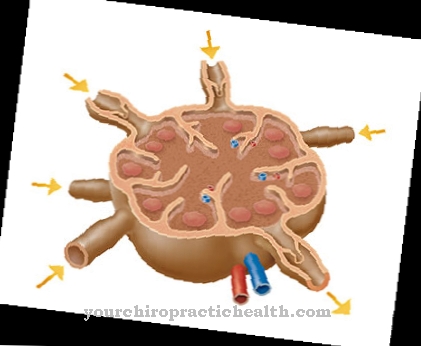Plantar warts are caused by infections on the soles of the feet, but are usually harmless. You can prevent them through good foot hygiene and the treatment is also unproblematic.
What are plantar warts?
.jpg)
© designua - stock.adobe.com
Plantar warts are changes in the skin in the area of the soles of the feet. The warts are caused by infection with certain types of the HPV virus.
Mostly people who have injuries, cracks or small skin injuries on the sole are affected. Plantar warts occur either individually or like beds and are found mainly in children and adolescents as well as people with a weak immune system.
causes
The cause of plantar warts lies in the human papillomavirus (HPV). If the skin is injured, the viruses can penetrate and cause an infection. However, infection with the viruses does not always occur.
The main risk of developing plantar warts is when the immune system is weakened or the virus can penetrate through several small injuries. Then it often takes several weeks or months for the first plantar warts to appear. Since the HPV viruses are not particularly contagious, the risk of transmission is also low.
Plantar wart viruses are mainly found in warm, humid environments. For example in shower rooms, changing rooms, swimming pools and saunas. The cause is often a visit to one of these places without appropriate protective measures. In addition, there must also be an entry point. Small cuts or scratches are just as sufficient as cracks or softened skin. Sweat also promotes the development of plantar warts.
Symptoms, ailments & signs
In most cases, plantar warts are a relatively harmless disease that does not lead to particular complications or serious complaints. It can therefore be treated relatively easily. Those affected primarily suffer from warts. These can appear on different parts of the body and are usually yellow or brown in color.
These warts limit the aesthetics of the person concerned, so that the patients can also suffer from a reduced self-esteem and also from inferiority complexes. In children, plantar warts can lead to bullying or teasing. The plantar warts occur mainly in places where there is a high pressure load.
They can also reach deep under the layers of the skin and are in many cases associated with severe pain. The pain usually occurs in the form of pressure pain, but can also lead to resting pain at night and thus to sleep problems for the patient. In rare cases, the plantar warts can also damage the nerves, so that the patient suffers from sensory disorders. This disease does not reduce or otherwise affect life expectancy.
Diagnosis & course
The diagnosis of plantar warts is based on various symptoms. The warts can be recognized by flat skin changes in yellowish or gray color in the area of the soles of the feet. They occur predominantly on the toes, heels and balls of the feet and are hidden under the callus.
Nevertheless, the warts can be clearly identified using small, dark points. The dermatologist can do additional tests to confirm his suspicions and make the exact diagnosis. For example, a scalpel is used to scrape off some callus from the suspicious area in order to get a closer look at the dots. A skin sample is usually also taken before the final diagnosis is made.
Plantar warts are unproblematic in the course of their disease. They usually heal on their own and rarely multiply. However, if the warts are painful, they must be treated to prevent nerve damage. This also prevents the infection of other people. However, therapy is extremely tedious and requires a lot of patience from the person affected. In addition, a completed treatment is no guarantee of a cure.
Complications
Plantar warts, also known as plantar warts, are severely keratinized skin changes in the soles of the feet. They develop during the transmission of papilloma viruses and are often found in children. The symptom usually disappears on its own with the onset of puberty. Adults, on the other hand, are more likely to need medical help in eliminating the very stubborn type of wart.
The risk of infection of the plantar warts lurks mostly in changing areas, bathing establishments and in the sauna through infected skin flakes and through a smear infection. In most cases, plantar warts behave relatively unobtrusively. Depending on the outgrowth, they can be cosmetic-related.
Sometimes it can happen that plantar warts spread and form painful areas. If those affected seek self-treatment, purulent inflammation and scars can result. In the early stages, plantar warts can easily be removed by the doctor. As the outgrowth increases, the symptom becomes more complicated and surgical intervention is necessary. This not only creates scars, it can also lead to bleeding and bruising.
Using home remedies can create backlashes, especially when using garlic and celandine. Self-therapy is not advisable if it concerns children under four years of age, people with a weakened immune system and impaired wound healing or circulatory disorders. Diabetics in particular should have plantar warts medically treated as there is a risk of nerve damage and sensitivity disorders in the foot area.
When should you go to the doctor?
Plantar warts generally do not require medical treatment. The growths can be treated with over-the-counter products from the pharmacy or various home remedies. However, it must be guaranteed that it is a plantar wart. The growth manifests itself through its characteristic wedge-shaped appearance and the yellowish-brown or gray color. If you are unsure whether it is actually a plantar wart, you should consult a doctor.
Medical advice is always required in the event of pain. Likewise, if the wart opens or there is even an inflammation. In the case of numbness or paralysis, there may already be serious nerve damage. These must be treated medically immediately. Otherwise, a medical clarification is necessary if there is an acute risk of infection.
A doctor should be consulted in the event of misalignments or other complaints. If several plantar warts are noticed all of a sudden, the cause of the infection should also be determined in addition to medical treatment. This and a quick examination can reliably prevent further spreading of the growths.
Doctors & therapists in your area
Treatment & Therapy
Plantar warts are usually completely harmless. They disappear on their own after a while and only reproduce in rare cases. However, various preparations can be used to remove the warts.
If nerve endings are pinched by the plantar warts, it is advisable to consult a doctor. He can suggest appropriate remedies with monochloroacetic acid or salicylic acid and keep an eye on the course of the disease. He can also rule out other diseases.
Another method is cold treatment. The plantar warts and their attachments are frozen with the help of preparations, whereby the affected tissue dies. The wart will then fall off on its own. However, it is also possible that none of the over-the-counter remedies work. Then the doctor has to do a local treatment and apply something like imiquimod. This stimulates the immune system to act against the HPV viruses. Laser ablation and so-called curettage can also be used. In the latter method, the doctor scrapes out the plantar wart with the help of a surgical tool.
In general, it is advisable to carry out the treatment in constant consultation with the doctor. This is especially true when the immune system is weakened or wound healing is impaired. It is also advisable to consult a doctor in the case of circulatory disorders. If children are affected by plantar warts, a doctor must always be consulted.
Outlook & forecast
With consistent treatment, plantar warts have a good prognosis. Often times, the path to recovery takes several weeks or months of disciplined therapy. The person concerned can carry out this on his own responsibility and independently. The horny layer is gradually rubbed with special medicines and then removed so that the wart recedes. The process is intense and needs to be done regularly. If the treatment is incorrect, the highly contagious warts often spread further.
Icing therapy has a better chance of a cure. In cryotherapy, stubborn or protracted plantar warts in particular are frozen by a doctor. Then they can no longer develop and ultimately fall off. In many cases, the patient is then considered symptom-free and can be discharged from treatment. However, there is always the possibility that the skin tumors will recur.
As soon as the affected person is re-infected by the papillomavirus, new warts can develop. The prognosis is unchanged if it occurs again. If consequential damage has already occurred through the plantar warts, it can lead to lifelong impairments. Although the plantar warts have healed and there are no symptoms, there is a possibility of a misalignment of the affected foot. This affects the skeletal system, muscles, tendons and nerve tracts in the foot.
prevention
Plantar warts can be effectively prevented. It is advisable to observe good foot hygiene and to treat the feet regularly with nourishing creams. In addition, you should always wear flip-flops in swimming pools and shower rooms. It also helps to keep your feet dry at all times and not to let them soften.
After a long shower, you should apply appropriate products to support the skin's natural protective film. If plantar warts are already present, they should not be scratched to prevent the virus from spreading. You should also wash your hands regularly if you have touched plantar warts.
↳ More information: Home remedies for warts
Aftercare
If the plantar wart is no longer visible and noticeable, it is the responsibility of the person concerned to initiate the necessary aftercare treatments. Since the pathogen is already in the body, a new outbreak occurs more quickly. The once infected area needs to be cleaned regularly to prevent this.
Commercially available soaps or disinfectants can be used for this. To avoid the formation of new warts, these areas must also be kept dry. Moist areas encourage repeated infection. When treating warts with a doctor, antibiotic creams / plasters are often indispensable for aftercare, as they treat the affected areas for a longer period of time.
Aftercare also includes consideration for other people. By covering up the former inflammation, direct and indirect spread of the virus is prevented. If no further dermatological changes can be observed in this region in the next few months, the wart is completely healed. It no longer needs any special attention.
However, the preventive measures for infections must still be observed. If the formation of warts is found again, a doctor should be consulted. Independent experimentation with wart killers from drug stores delays adequate treatment. With timely therapy, long procedures are prevented.
You can do that yourself
Because plantar warts are generally considered harmless, they can also be treated by yourself. In the pharmacy, for example, various drugs are offered for self-therapy that are freely available. These include a. Preparations containing salicylic acid.
They are usually administered in the form of solutions for application or as a plaster that is stuck to the plantar wart. Salicylic acid has the effect of loosening the cornea. Through this process, the area of skin to be treated can be removed step by step. Liquid preparations containing salicylic acid are usually used for 6 to 12 weeks. Corresponding plasters remain on the plantar wart for a few days.
Cold therapy is another effective means of self-treating a plantar wart. For example, some manufacturers offer preparations whose effect is to freeze the wart. At temperatures as low as -57 degrees Celsius, the treated tissue eventually dies, which only takes a few days.
New layers of skin then form underneath. However, in most cases the cornea is located above the plantar wart. For a successful home cold treatment, it is therefore advisable to remove the callus before freezing. Some people may need two or three treatments before they work. However, there should be a break of around two weeks between therapies.
It also makes sense to use monochloroacetic acid. Monochloroacetic acid preparations, for example, also loosen the cornea, but they only need to be used once a week.





.jpg)





















